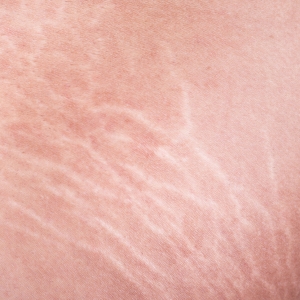
Dr. Kevin McKerrow
DERMATOLOGIST
+ SEE BIO
Stretch marks are a common form of scarring on the skin, affecting many people. There are two types of stretch marks – red (new) stretch marks, and white (old) stretch marks. New stretch marks are more responsive to treatment than old stretch marks.
Stretch marks, as the name suggests, are due to stretching of the skin, resulting in altered structural support in the deeper layers of the skin. Histologic studies of stretch marks confirm alteration in collagen and decreased elastin, as well as swelling in the deeper layers of the skin. New red stretch marks exhibit an increase in the number of blood vessels and inflammation, resulting in the pink/purple discoloration which can make them more responsive to treatment. The majority of stretch marks will improve over time, changing from red/purple to pink and then finally achieving a wrinkled appearance.
The initial signs of stretch marks are pink to purple lines, usually running crosswise on the trunk and lengthwise along the limbs. Occasionally they can be itchy. With time, stretch marks lighten and develop a pale, wrinkled appearance. Stretch marks usually occur in areas involving the breast, abdomen, thighs, groins and buttocks. They may also develop in the groin and armpits if high-strength steroid creams are inappropriately used in these areas.
Puberty and weight gain: In puberty stretch marks may occur on the back, abdominal areas, hips, thighs and breasts. Weightlifters often develop stretch marks on their arms from the increase in muscle mass over a short period of time.
Pregnancy: This is thought to be caused by hormonal changes and weight gain associated with the pregnancy. Stretch marks most commonly develop in the third trimester of pregnancy.
Medications: Cortico-steroid creams, ointments or tablets may cause stretch marks if used inappropriately and without dermatological supervision.
Diseases: Cushings syndrome and Marfan’s syndrome can predispose a patient to developing stretch marks.
Stretch marks are a cosmetic problem and treatment is optional. The majority of stretch marks will fade over time. New red stretch marks respond better to treatment than older, white stretch marks. No treatment will remove stretch marks completely. We provide the widest range of laser and radio-frequency device treatments for stretch marks in New Zealand.
Treatments for red stretch marks:
Treatment of White Stretch Marks: